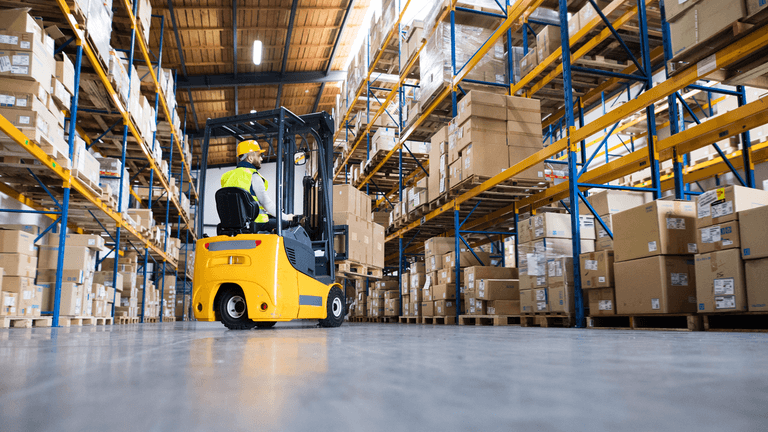Moving to this day and age, it is undeniable that warehousing plays an important role in the whole business since the world is becoming a global village. Warehousing accounts for the foundation of storing products, making it better customer service and reducing costs for firms. While it may not be the most exciting topic, warehousing and inventory storage have an impact on everything from procuring raw materials to properly managing inventory to sending orders to customers on time. In this article, let’s see what warehousing in logistics is and the functions of warehousing in logistics.
Table of Contents
What is warehousing in logistics?
Warehousing is defined as a significant component of a basic logistic process, which comprises actions in the area of supply management, or the organization of inlet and outlet, in other words, inflows and outflows of goods in an organization.
Warehousing logistics is one of the directions of the general theory of logistics, which solves the problems of organizing a warehouse, forming a system for receiving, accounting and placing stocks in a warehouse.
The importance of warehousing in logistics
Warehousing is essential in supply chain management as goods are transported from the maker to end recipient. The benefits of warehousing in logistics indicates that if a warehouse operation is ineffective, the entire supply chain may be immobilized, for example, a lack of goods, delays, or blockages. All logistical efforts performed within the scope of a warehouse should avoid the warehouse from becoming a bottleneck of the supply chain.
The purpose of warehouses is to support manufacturing processes, which can be accomplished by maintaining sufficient resources, materials, and packaging for production, allowing for uninterrupted output. Permanent access to packages allows for the systematic receipt of finished goods and delivery to the intended recipient. It’s worth noting that warehouses support marketing processes by providing constant access to resources required for the completion of a promotional action or the production of promotional sets.
The role of warehousing in a logistics system
- Transport: For the movement of goods from the supplier to the buyer, transportation is the most fundamental and important component of logistics. This is the movement of the product from one supplier to the buyer. In general, the buyer does not directly receive the products from the supplier. They have to be transported from the point of production to the final destination. Consolidating transportation allows businesses to reduce money on logistics, which is especially essential for businesses that ship goods across short distances.
- Carry out quality controls: The exact size, weight, number, and configuration of any of the products stored in a central warehouse must be recorded accurately so that the correct part can be delivered at the right place and time. Traditional quality control techniques include verification checks, visual verification checks, and reading a code from the product or container. Verification checks of the product or container, which are more complex and expensive, are becoming more important. Inventory control: Inventory management is to keep enough inventories to meet customer requirements, and simultaneously its carrying cost should be the lowest. This system is effective in the management of inventory to meet the customer needs and also to handle its accounting operations such as inventory valuation and inventory valuation.
- Product quality: When a product meets a customer’s expectations, it is said to be of high quality. Customers frequently request distinctive commodities in differing quantities when placing an order. While businesses produce their products in batches, frequently in contracted facilities, they do so in batches. In this scenario, storage can help minimize the time it takes for products to flow and ensure that the order is fulfilled efficiently.
- Customer service: Offering products in a given place and at a given time is a service that logistics should handle. It’s also important in supply warehouses since it’s easier to plan a manufacturing schedule (while still having enough supplies), which translates to faster order fulfillment. It’s important to remember that client demand is unpredictable, and suppliers can’t predict the costs of running out of stock.
- Protection from unexpected events: (suppliers running out of goods, transportation delays, or a strike). Delays in the supply of raw materials might cause the production process to halt, which is a bad thing for a business. In distribution warehouses, a condition of unexpected events can also occur. Damaged items during transit may have an impact on stock levels and order fulfillment effectiveness.
- Smoothen the goods flows which is of special importance in case of seasonal fluctuations.
Functions of warehousing in logistics
Functions of warehousing in logistics are divided into three groups:
Realization of warehousing actions and tasks: It includes all actions related to the completion of warehouse projects (acceptance of goods, storage, preparation of documents, the release of supplies, registering and recording stocks, revealing losses during the warehousing process). The warehouse management procedure allows acceptance, storage and release of supplies based on the material turnover documentation, protection of supplies, current maintenance of supplies with consideration of sensitive goods, all the records of materials and control of stock.
Warehouse management: Warehouse management encompasses planning, organizing, coordinating, and controlling, which in relation of:
- Planning a warehouse operation and works completed on various time scales.
- Operations and processes (technical and human resource management);
- Control of the warehouse operation (instructions, dispositions, documentation).
- Implementation of organizational authorizations.
Registration of places, supplies, and warehouse buildings: The location of a warehouse in a supply chain has an impact on its organization, equipment, and planning of warehouse operations, but it is also important for the problem of warehouse location and functions, such as product conditioning in a traditional warehouse adjacent to a facility or in logistic centers, which reduces the time goods are kept in the warehouse.
Types of warehousing in logistics
- Public Warehouses: Governmental agencies own public warehouses, which they make available to commercial businesses. Both commercial and personal usage of public warehouses is permitted.
- Private Warehouses: A warehouse that is privately owned by wholesalers, distributors, or manufacturers is known as a private warehouse. Large retail and online marketplaces also have their own warehouses that are privately owned. Although private warehouses are often more expensive than public warehouses, they can still be a good alternative for eCommerce SMBs who want a large, long-term strategic presence in a key location.
- Bonded Warehouses: A bonded warehouse is a sort of warehouse that can keep imported goods before paying customs duties on them. When corporations rent space from them, the authorities provide them with bonds to ensure that they will not lose money when their items are distributed. Companies that store products in them are exempt from paying customs until the products are released. Restricted things can also be stored in them while their documentation is completed. A bonded warehouse also has the capability of storing products for long periods of time.
- Smart Warehouse: AI is used to automate the storage, fulfillment, and management processes. Automation can range from management software to robots and drones that handle operations such as packing, weighing, transporting, and storing items. Amazon and Alibaba, for example, deploy massive smart warehouses to expedite order fulfillment and reduce the risk of human error.
- Consolidated Warehouses: Consolidated warehouse collects small shipments from many suppliers and consolidates them into larger shipments before distributing them to customers. The only problem is that all of the shipments are going to the same place. Consolidated warehouses, on the other hand, are a very cost-effective method of order fulfillment, particularly for small enterprises and new companies. Consolidated warehouses also demand a low initial capital investment and inventory volume, making them an excellent choice for eCommerce SMBs just getting started.
- Distribution Centers: A distribution center is a storage facility that is usually designed to meet specific needs. The storage is only used for short-term needs, and things are moved throughout the supply chain fast. In a short period of time, a considerable amount of goods is received and delivered to resellers and merchants. Some food and perishable commodities are frequently distributed within a day from distribution facilities. In general, distribution centers are inexpensive to rent and might vary substantially based on the products that are housed there.
>> Read more: 5 Different warehousing types and the new warehousing software solution
Conclusion
In the new world, the significance of logistics for the competitive position of enterprises is certain. Warehousing in logistics is a crucial element of companies’ operations, and it poses a basic component for the development of the customer service process in an enterprise. Understanding the foundation rule would bring a competitive advantage for firms.











